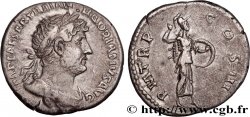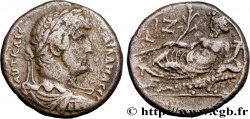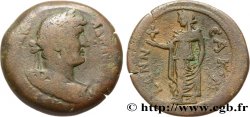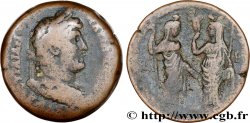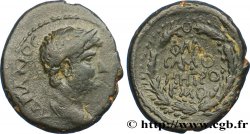bpv_317772 - HADRIAN Tétradrachme syro-phénicien
无库存.
所有在网站上销售的产品 (2014)
价格 : 280.00 €
所有在网站上销售的产品 (2014)
价格 : 280.00 €
种类 Tétradrachme syro-phénicien
日期: 117-118
铸币厂名称/城市 Aigeai, Cilicie
材质 silver
直径 26 mm
模子方针 12 h.
重量 13,42 g.
稀少度 R2
出版目录中的项代码 :
家谱
Cet exemplaire, qui provient de la Collection de Richard McAlee, illustre le type dans le Prieur et est le 0718_002 de la base TSP
正面
正面的说明书 Buste lauré et cuirassé d’Hadrien à droite, vu de trois-quarts de face (B*01), avec un drapé sur l’épaule gauche.
正面铭文 AUTOK KAIS TRAIANOS ADRIANOS SEB (Autokratoros Kaisaros Traianos Adrianos Sebastos)
正面的翻译 (L’empereur césar Trajan Hadrien auguste).
背面
背面的说明书 Aigle de face, ailes déployées, tête et queue à droite, sur une ligne de terre, une chèvre à droite à l’exergue.
背面铭文 AIGEAIWN/ ETOUS DΞR
背面的翻译 (D’Aigeai, an 164 de l’ère césarienne).
评论
Les émissions d’Aigaie sont intégrées dans le Prieur car les tétradrachmes montrent une participation à la zone monétaire d’Antioche. Certes, un trésor mixte d’émissions d’Aigaie et d’Antioche serait le bienvenu pour confirmer une circulation commune.
On ne peut qu’amèrement déplorer que les circonstances légales et autres n’aient pas permis d’étudier correctement l’important trésor apparu sur le marché dont il semble qu’il ne contenait que des monnaies d’Aigaie... mais comment en être sûr ?
Hors une partie qui se trouve encore chez le professionnel américain à l’origine de la publication partielle par Lorber-Michaels, la trouvaille semble complètement dispersée et il n’apparait plus guère d’exemplaires sauf les dates les plus banales (Prieur 721, connu à cinq exemplaires à la publication et répertorié maintenant à cent deux exemplaires).
Aigeai était située sur le golfe d'Issos, à l'opposé d'Alexandrie fondée par Alexandre III le Grand afin de commémorer la grande bataille qui avait opposé les Grecs et les Perses en 333 avant J.-C. C’était un port important.
Le choix de la chèvre dans le champ à droite est lié à un jeu de mot entre le nom AIGEIWN (des chèvres) et le nom de la cité (AIGEIAWN)
On ignore pourquoi Aigeai, dont les frappes autonomes, excessivement rares, s’interrompent en 30 avant J.-C. va frapper, sous Hadrien, une série importante et variée, à plusieurs faciales, aux types souvent recherchés, incluant même Sabine sur certains revers.
Il est probable, de la même manière que nous avons une rarissime émission commémorative de la ville sous Caracalla, que la motivation est le séjour de l’Empereur dans la ville et le motif de son séjour, le même que sous Caracalla, le temple d’Asclépios et d’Hygie, les divinités de la Médecine.
Il y eut probablement en réalité deux séjours, le premier vers 117/118 AD, où sont frappés une série de tridrachmes dont l’un au revers d’Hygie et du serpent, et notre tétradrachme.
L’autre passage se situe vers 130/134, sur un rythme annuel avec une émission de tétradrachmes comme le nôtre, au revers de l’aigle, poids moyen vers 13,5 g, et en 133/134 une série de tridrachmes à flan large et à l’aspect de tétradrachmes, d’un poids moyen oscillant autour de 9,5 g, uniquement des émissions commémoratives (Sabine, Asclépios, pas de revers à l’aigle).
Ces émissions sont importantes car elles se placent entre les usages de Césarée pour les poids et ceux d’Antioche pour le type et l’aspect.
On doit noter que cette émission, contrairement à celle de 130/131 mais comme les suivantes, écrit les S en sigma et non pas en C.
Dans la base TSP maintenue par Michel Prieur, quatorze exemplaires sont maintenant répertoriés pour le 718, un seul en musée, à Paris.
The Aigaie issues are included in the Priory because the tetradrachms show participation in the Antioch monetary zone. Certainly, a mixed treasure of issues from Aigaia and Antioch would be welcome to confirm a common circulation..
It can only be bitterly regretted that legal and other circumstances did not allow for a proper study of the important treasure that appeared on the market, which appears to have contained only coins from Aigaie.. . . but how can we be sure? Apart from a part which is still with the American professional who was behind the partial publication by Lorber-Michaels, the find seems completely dispersed and there are hardly any more examples except for the most banal dates (Prieur 721, known to be five examples at publication and now listed at one hundred and two examples).
Aigeai was located on the Gulf of Issus, opposite Alexandria, founded by Alexander III the Great to commemorate the great battle between the Greeks and the Persians in 333 BC.. -C. It was an important port.
The choice of the goat in the field on the right is linked to a play on words between the name AIGEIWN (goats) and the name of the city (AIGEIAWN). We do not know why Aigeai, whose autonomous strikes, excessively rare, stopped in 30 BC.. -C. will strike, under Hadrian, an important and varied series, with several facial features, with often sought-after types, even including Sabine on certain reverses.
It is likely, in the same way that we have a very rare commemorative issue of the city under Caracalla, that the motivation is the stay of the Emperor in the city and the reason for his stay, the same as under Caracalla, the temple of Asclepius and Hygieia, the divinities of Medicine.
There were probably actually two stays, the first around 117/118 AD, where a series of tridrachms were struck, one of which has the reverse of Hygieia and the serpent, and our tetradrachm.
The other passage is around 130/134, on an annual rhythm with an issue of tetradrachms like ours, on the reverse of the eagle, average weight around 13.5 g, and in 133/134 a series of tridrachms with a wide flan and the appearance of tetradrachms, with an average weight oscillating around 9.5 g, only commemorative issues (Sabine, Asclepius, no reverse with the eagle).
These emissions are important because they are placed between the customs of Caesarea for weights and those of Antioch for type and appearance.
It should be noted that this issue, unlike that of 130/131 but like the following ones, writes the S in sigma and not in C.
In the TSP database maintained by Michel Prieur, fourteen examples are now listed for the 718, only one in a museum, in Paris
On ne peut qu’amèrement déplorer que les circonstances légales et autres n’aient pas permis d’étudier correctement l’important trésor apparu sur le marché dont il semble qu’il ne contenait que des monnaies d’Aigaie... mais comment en être sûr ?
Hors une partie qui se trouve encore chez le professionnel américain à l’origine de la publication partielle par Lorber-Michaels, la trouvaille semble complètement dispersée et il n’apparait plus guère d’exemplaires sauf les dates les plus banales (Prieur 721, connu à cinq exemplaires à la publication et répertorié maintenant à cent deux exemplaires).
Aigeai était située sur le golfe d'Issos, à l'opposé d'Alexandrie fondée par Alexandre III le Grand afin de commémorer la grande bataille qui avait opposé les Grecs et les Perses en 333 avant J.-C. C’était un port important.
Le choix de la chèvre dans le champ à droite est lié à un jeu de mot entre le nom AIGEIWN (des chèvres) et le nom de la cité (AIGEIAWN)
On ignore pourquoi Aigeai, dont les frappes autonomes, excessivement rares, s’interrompent en 30 avant J.-C. va frapper, sous Hadrien, une série importante et variée, à plusieurs faciales, aux types souvent recherchés, incluant même Sabine sur certains revers.
Il est probable, de la même manière que nous avons une rarissime émission commémorative de la ville sous Caracalla, que la motivation est le séjour de l’Empereur dans la ville et le motif de son séjour, le même que sous Caracalla, le temple d’Asclépios et d’Hygie, les divinités de la Médecine.
Il y eut probablement en réalité deux séjours, le premier vers 117/118 AD, où sont frappés une série de tridrachmes dont l’un au revers d’Hygie et du serpent, et notre tétradrachme.
L’autre passage se situe vers 130/134, sur un rythme annuel avec une émission de tétradrachmes comme le nôtre, au revers de l’aigle, poids moyen vers 13,5 g, et en 133/134 une série de tridrachmes à flan large et à l’aspect de tétradrachmes, d’un poids moyen oscillant autour de 9,5 g, uniquement des émissions commémoratives (Sabine, Asclépios, pas de revers à l’aigle).
Ces émissions sont importantes car elles se placent entre les usages de Césarée pour les poids et ceux d’Antioche pour le type et l’aspect.
On doit noter que cette émission, contrairement à celle de 130/131 mais comme les suivantes, écrit les S en sigma et non pas en C.
Dans la base TSP maintenue par Michel Prieur, quatorze exemplaires sont maintenant répertoriés pour le 718, un seul en musée, à Paris.
The Aigaie issues are included in the Priory because the tetradrachms show participation in the Antioch monetary zone. Certainly, a mixed treasure of issues from Aigaia and Antioch would be welcome to confirm a common circulation..
It can only be bitterly regretted that legal and other circumstances did not allow for a proper study of the important treasure that appeared on the market, which appears to have contained only coins from Aigaie.. . . but how can we be sure? Apart from a part which is still with the American professional who was behind the partial publication by Lorber-Michaels, the find seems completely dispersed and there are hardly any more examples except for the most banal dates (Prieur 721, known to be five examples at publication and now listed at one hundred and two examples).
Aigeai was located on the Gulf of Issus, opposite Alexandria, founded by Alexander III the Great to commemorate the great battle between the Greeks and the Persians in 333 BC.. -C. It was an important port.
The choice of the goat in the field on the right is linked to a play on words between the name AIGEIWN (goats) and the name of the city (AIGEIAWN). We do not know why Aigeai, whose autonomous strikes, excessively rare, stopped in 30 BC.. -C. will strike, under Hadrian, an important and varied series, with several facial features, with often sought-after types, even including Sabine on certain reverses.
It is likely, in the same way that we have a very rare commemorative issue of the city under Caracalla, that the motivation is the stay of the Emperor in the city and the reason for his stay, the same as under Caracalla, the temple of Asclepius and Hygieia, the divinities of Medicine.
There were probably actually two stays, the first around 117/118 AD, where a series of tridrachms were struck, one of which has the reverse of Hygieia and the serpent, and our tetradrachm.
The other passage is around 130/134, on an annual rhythm with an issue of tetradrachms like ours, on the reverse of the eagle, average weight around 13.5 g, and in 133/134 a series of tridrachms with a wide flan and the appearance of tetradrachms, with an average weight oscillating around 9.5 g, only commemorative issues (Sabine, Asclepius, no reverse with the eagle).
These emissions are important because they are placed between the customs of Caesarea for weights and those of Antioch for type and appearance.
It should be noted that this issue, unlike that of 130/131 but like the following ones, writes the S in sigma and not in C.
In the TSP database maintained by Michel Prieur, fourteen examples are now listed for the 718, only one in a museum, in Paris







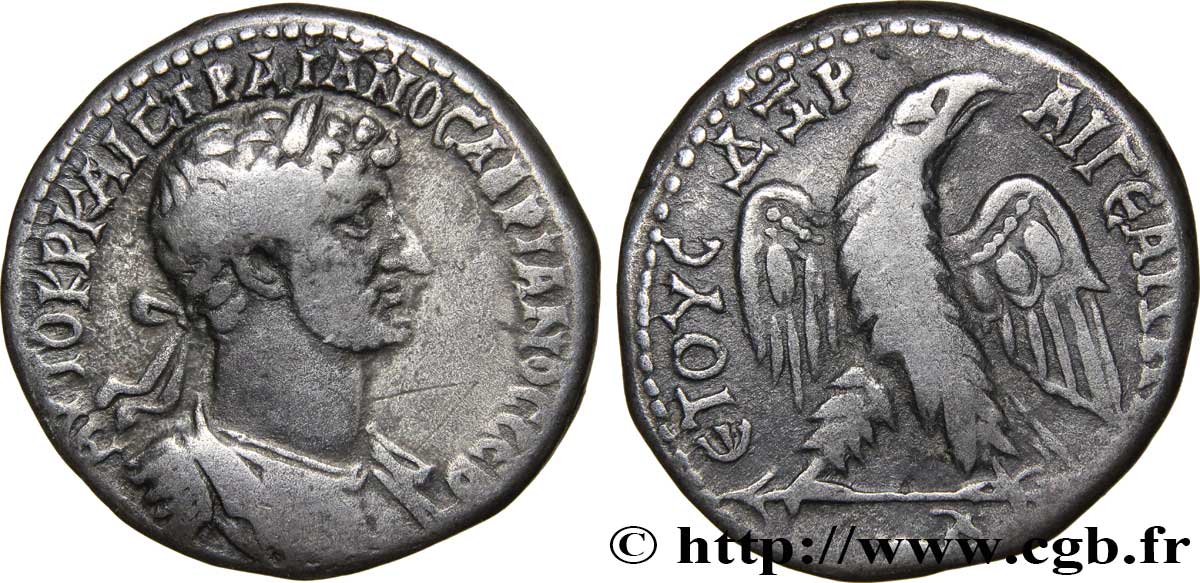
 对产品描述纠错
对产品描述纠错 打印
打印 分享我的选择
分享我的选择 提问
提问 Consign / sell
Consign / sell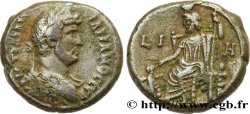
 产品介绍
产品介绍